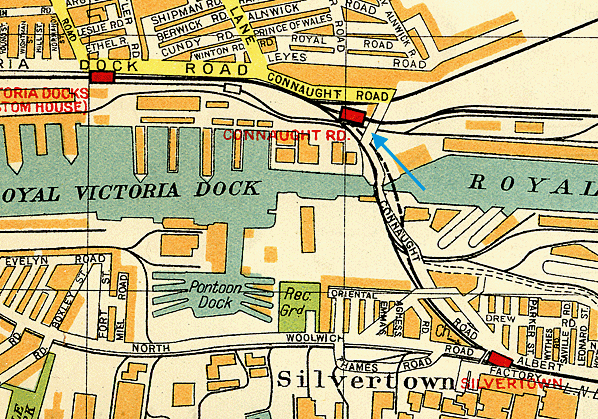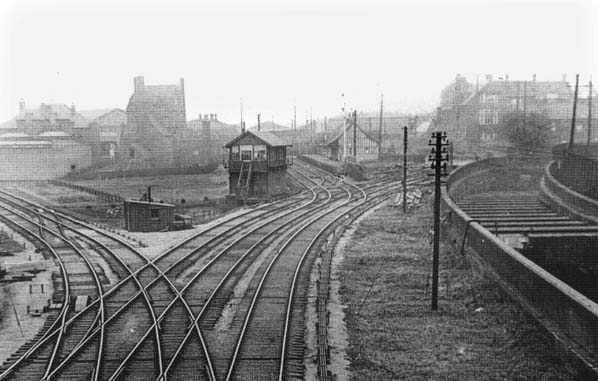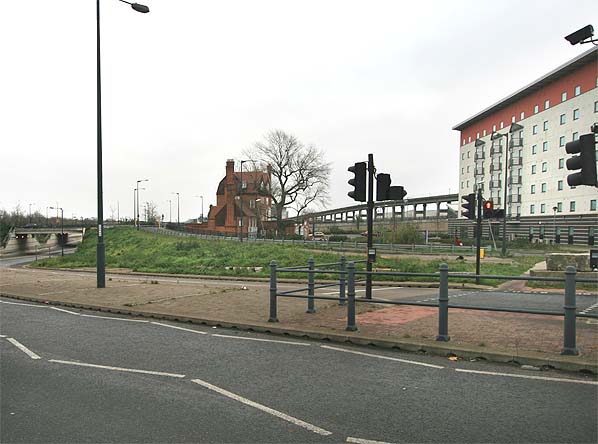|
Notes: Although Connaught Road Station opened on 3rd August
1880 it didn't appear in timetables until November 1880. The
station was located 220 yards to the east of Albert Dock Junction.
The main building on the up side of the line was built in a
mock Tudor style with a small waiting shelter on the down platform.
Nothing remained of the station by the mid 1950's.
BRIEF HISTORY OF THE GALLIONS
BRANCH
When the Royal Albert Dock was built, the dock company obtained
powers under the 1882 London & St. Katharine Dock Act 1882
to build a railway for both passengers and parcels from the
North Woolwich line to Gallions Reach, passing alongside the
northern side of the dock. Under the Act, the company had to
provide trains every weekday morning for the convenience of
"artisans, mechanics and daily labourers".
The length of the branch once open to passenger traffic was
1 mile, 61 chains, from a point 34 chains east of Custom House
Station.
The first part of the line from Albert Dock Junction to Central
was opened on the 3rd August 1880. The line between Connaught
Road and Central was single but was doubled on 14th November
1881.
Initially the service between Custom House and Central was
worked entirely by the London & St. Katharine Docks Company
with half-hourly trains from 8.30 a.m. till 6 p.m. but this
was later increased to three per hour in 1881. To operate this
service the company bought three second hand locomotives and
passenger stock.
No mention of a service east of Central Station is found in
the Great Eastern timetables until July 1881, when that company
advertised through trains hourly to and from Fenchurch Street.
The local Custom House - Gallions service comprised twenty-four
down and twenty-six up trains, all worked by the dock company,
who hired the bay platform at Custom House for the purpose.
The line between Central and Gallions was single until 1st April
1882 when a second track was added.
The Gallions Hotel was part of Gallions Station with the front
door of the hotel opening on to a part of the platform. It was
built for the convenience of passengers leaving or joining their
ship. From the 12th December 1886, the old station at Gallions
was closed when the line had to be diverted to allow dock alterations.
A larger station with an island platform was opened 275 yards
further east with Great Eastern trains occupying the north side
(platform 1), and the dock company's trains, on the local service,
kept to the south side (platform 2). A few weeks later a new
station replaced the old one at Manor Way. The line continued
beyond the station at Gallions to a coal wharf and jetty at
Gallions Reach.
On 31st March 1909 the London & St. Katharine Docks Company
was absorbed into the Port of London Authority.
During the First World War, from the beginning of 1918, a special
train service to Gallions was provided for munitions workers,
who were brought by ferry from Woolwich Arsenal on the opposite
side of the river.
The stations at Manor Way and Gallions were rebuilt between
1924 and 1926, the latter being reduced in size moved a little
to the east. Central Station was converted into a halt from
the 1st November 1933.
From 1st July 1896 the Great Eastern Railway took over the
local Customs House - Gallions service running until 6th June
1932, when the shuttle service was suspended. The Sunday service
ceased after 27th June 1915.
The prosperity of the line reached its climax at the turn of
the century; in October 1900, fifty four up and fifty-three
down trains were advertised on ordinary weekdays. Of these,
thirteen were through trains from Fenchurch Street to Gallions
via Bromley, two trains worked through from Liverpool Street,
two from Fenchurch Street via Stratford and two came from Stratford
Market. The local service of seventy trains in both directions
made up the remainder, bringing the total to 107 journeys. In
general, trains called at all three intermediate stations but
there were some exceptions.
Passenger numbers dropped during WW1 and didn't improve post
war and the service was cut back with seventy six fewer journeys
in 1938 than in 1900. By October 1939, the total in both directions
had dropped to twenty eight daily trains.
On the 7th September 1940 the line was severely damaged during
a German air raid. The line was repaired for the storage of
wagons but the passenger service was never reinstated. The line
was abandoned under Section 29 of the Port of London Act 1950.
It was used for wagon storage at least until the mid 1960's.
By the late 1960's the track had been lifted except at Gallions
where it was still in situ until at least 1974. With the lifting
of the track to the east, Gallions was later reached via a connection
from freight lines to the south.
Sources:
To see the other stations on
the Gallions branch line click on the station name: Central,
Manor Way (1st site),
Manor Way (2nd site)
Gallions (1st site)
& Gallions (2nd site)
See also North
Woolwich & Beckton
branch lines
|

old2.jpg)



 Home Page
Home Page 


